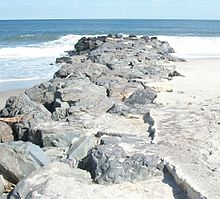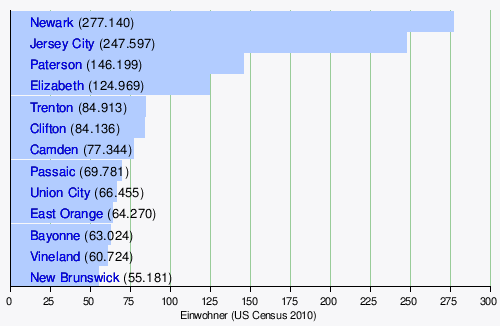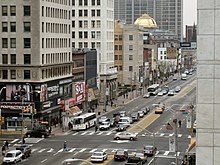New Jersey
![]()
The title of this article is ambiguous. For other meanings, see New Jersey (disambiguation).
New Jersey ([njuːˈdʒɜːzi] BE / [![]()
![]() nuːˈdʒɝzi] AE, German older also Neujersey) is (after Rhode Island, Delaware and Connecticut) the fourth smallest state in the United States and at the same time the one with the highest population density. New Jersey was named after the Channel Island of Jersey. The state is nicknamed The Garden State and is one of the Mid-Atlantic states.
nuːˈdʒɝzi] AE, German older also Neujersey) is (after Rhode Island, Delaware and Connecticut) the fourth smallest state in the United States and at the same time the one with the highest population density. New Jersey was named after the Channel Island of Jersey. The state is nicknamed The Garden State and is one of the Mid-Atlantic states.
Geography
Area, location and overview information
New Jersey has a total area of 22,588 km², of which 3377 km² is water. The state borders New York to the north and northeast, where the Hudson River partially forms a natural border. To the west, New Jersey is completely separated from the states of Pennsylvania and Delaware by the Delaware River. In the south, in the Delaware Bay, and in the east, New Jersey finally has shares of the Atlantic Ocean.
The state has roughly the shape of the head and torso of a human being, whose head is slightly bent forward. From this image, the head, or northern part of the state, is the region with the larger elevations in an otherwise flat country. Here in the Great Appalachian Valley (also known as the Kittatinny Valley), which stretches from the U.S. state of Alabama to the Hudson River, on the border with the state of New York is High Point, New Jersey's highest mountain, which at 550 meters exceeds the average height of the country by more than seven times.
The eastern part of the country, the catchment area of the Hudson and New York City, the largest US city with over a million inhabitants, is densely populated. The metropolitan area west of the Hudson already includes all four of the country's major cities: Newark, Jersey City, Paterson and Elizabeth.
South of it begins the Atlantic coastal plain, which is a popular holiday destination with its numerous seaside resorts over a length of more than 200 km. The coastal strip is relatively densely populated, especially in the northern and then again in the southern part, with their numerous middle towns lined up next to each other. The largest cities along the coast are Long Branch in the north and Atlantic City in the south, which is important for tourism.
In the interior to the southern part, dense forests characterize the image of the state. A well-known and popular destination in this region are the Pine Barrens, which are under nature protection and to which the myth of the Jersey Devil adheres.
Structure
- List of counties in New Jersey

View of the Atlantic Ocean. Sea Bright, New Jersey
Population
| Population development | |||
| Census | Inhabitants | ± in % | |
| 1790 | 184.139 | - — | |
| 1800 | 211.149 | 14,7 % | |
| 1810 | 245.562 | 16,3 % | |
| 1820 | 277.575 | 13 % | |
| 1830 | 320.823 | 15,6 % | |
| 1840 | 373.306 | 16,4 % | |
| 1850 | 489.555 | 31,1 % | |
| 1860 | 672.035 | 37,3 % | |
| 1870 | 906.096 | 34,8 % | |
| 1880 | 1.131.116 | 24,8 % | |
| 1890 | 1.444.933 | 27,7 % | |
| 1900 | 1.883.669 | 30,4 % | |
| 1910 | 2.537.167 | 34,7 % | |
| 1920 | 3.155.900 | 24,4 % | |
| 1930 | 4.041.334 | 28,1 % | |
| 1940 | 4.160.165 | 2,9 % | |
| 1950 | 4.835.329 | 16,2 % | |
| 1960 | 6.066.782 | 25,5 % | |
| 1970 | 7.168.164 | 18,2 % | |
| 1980 | 7.364.823 | 2,7 % | |
| 1990 | 7.730.188 | 5 % | |
| 2000 | 8.414.347 | 8,9 % | |
| 2010 | 8.791.894 | 4,5 % | |
| Before 1900 1900–1990 2000 2010 | |||
New Jersey residents are colloquially called "New Jerseyans" or "New Jerseyites."
New Jersey has a population of 8,682,661 (2008 estimate), of which 69.6% are white, 15.6% Latino, 13.6% African American, 7.5% Asian, and 0.2% Hawaiian or from other Pacific Islands.
In 2005, 1.9 million, or 19.2% of all residents, were born outside the United States. According to the United States Census Bureau, New Jersey is the second wealthiest state after Maryland.
Age and gender structure
The age distribution of New Jersey is as follows:
- up to 18 years: 2,089,653 (24.0 %)
- 18-64 years: 5,509,302 (63.1 %)
- 65 years and older: 1,125,605 (12.9 %)
The median age is 38.2 years. 48.8% of the population is male and 51.2% is female.
Ancestry
18.1% of the inhabitants are of Italian descent and thus represent the largest fraction. This is followed by the groups of Irish (16.1%), German (15.7%), Polish (6.7%) and English (6.0%) origin.
Largest cities

- List of cities in New Jersey

New Jersey Population Density Map

Newark
Questions and Answers
Q: What is the capital of New Jersey?
A: The capital of New Jersey is Trenton.
Q: What is the largest city in New Jersey?
A: The largest city in New Jersey is Newark.
Q: What is the state nickname for New Jersey?
A: The state nickname for New Jersey is "The Garden State".
Q: Who is the current governor of New Jersey?
A: The current governor of New Jersey is Phil Murphy.
Q: How many people live in New Jersey compared to its size?
A: Although it's one of the smallest states, it has the eleventh highest number of people, making it have the highest population density (number of people for amount of land) in the United States.
Q: What are some things that make up its geography and climate?
A: Its geography includes bordering Pennsylvania and Delaware across the Delaware River, on the north by New York, on east and southeast by Atlantic Ocean, and on southwest by Delaware Bay. It also has beaches, industries, swamps, and pine forests with a hot and humid summer climate with cold winters and about 47 in (1,200 mm) precipitation every year. Average temperatures range from 82 °F (28 °C) to 87 °F (31 °C) during summer months to 16 °F (-9 °C) to 34 °F (1 °C) during winter months.
Q: How close are major cities like Philadelphia or NYC to NJ?
A:New York City and Philadelphia are both very close to NJ as they border it along different sides - NYC borders NJ on its northeast side while Philadelphia borders NJ on its west side across Delaware River.
Search within the encyclopedia